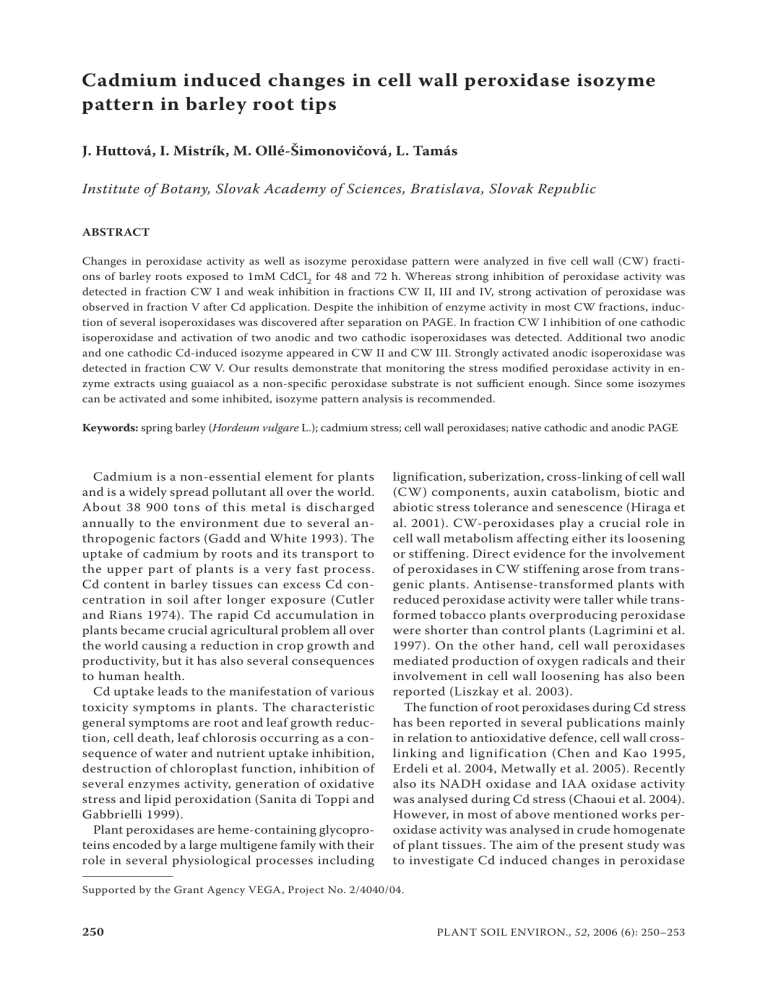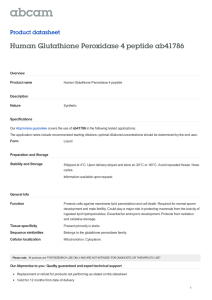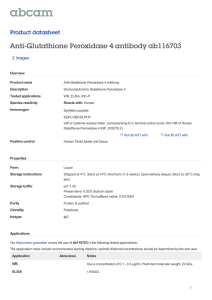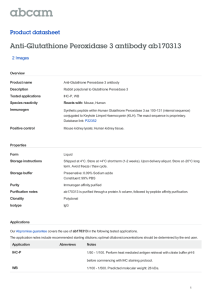Cadmium induced changes in cell wall peroxidase isozyme pattern

Cadmium induced changes in cell wall peroxidase isozyme pattern in barley root tips
J. Huttová, I. Mistrík, M. Ollé-Šimonovičová, L. Tamás
Institute of Botany, Slovak Academy of Sciences, Bratislava, Slovak Republic
ABSTRACT
Changes in peroxidase activity as well as isozyme peroxidase pattern were analyzed in five cell wall (CW) fractions of barley roots exposed to 1mM CdCl
2
for 48 and 72 h. Whereas strong inhibition of peroxidase activity was detected in fraction CW I and weak inhibition in fractions CW II, III and IV, strong activation of peroxidase was observed in fraction V after Cd application. Despite the inhibition of enzyme activity in most CW fractions, induction of several isoperoxidases was discovered after separation on PAGE. In fraction CW I inhibition of one cathodic isoperoxidase and activation of two anodic and two cathodic isoperoxidases was detected. Additional two anodic and one cathodic Cd-induced isozyme appeared in CW II and CW III. Strongly activated anodic isoperoxidase was detected in fraction CW V. Our results demonstrate that monitoring the stress modified peroxidase activity in enzyme extracts using guaiacol as a non-specific peroxidase substrate is not sufficient enough. Since some isozymes can be activated and some inhibited, isozyme pattern analysis is recommended.
Keywords: spring barley ( Hordeum vulgare L.); cadmium stress; cell wall peroxidases; native cathodic and anodic PAGE
Cadmium is a non-essential element for plants and is a widely spread pollutant all over the world.
About 38 900 tons of this metal is discharged annually to the environment due to several anthropogenic factors (Gadd and White 1993). The uptake of cadmium by roots and its transport to the upper part of plants is a very fast process.
Cd content in barley tissues can excess Cd concentration in soil after longer exposure (Cutler and Rians 1974). The rapid Cd accumulation in plants became crucial agricultural problem all over the world causing a reduction in crop growth and productivity, but it has also several consequences to human health.
Cd uptake leads to the manifestation of various toxicity symptoms in plants. The characteristic general symptoms are root and leaf growth reduction, cell death, leaf chlorosis occurring as a consequence of water and nutrient uptake inhibition, destruction of chloroplast function, inhibition of several enzymes activity, generation of oxidative stress and lipid peroxidation (Sanita di Toppi and
Gabbrielli 1999).
Plant peroxidases are heme-containing glycoproteins encoded by a large multigene family with their role in several physiological processes including lignification, suberization, cross-linking of cell wall
(CW) components, auxin catabolism, biotic and abiotic stress tolerance and senescence (Hiraga et al. 2001). CW-peroxidases play a crucial role in cell wall metabolism affecting either its loosening or stiffening. Direct evidence for the involvement of peroxidases in CW stiffening arose from transgenic plants. Antisense-transformed plants with reduced peroxidase activity were taller while transformed tobacco plants overproducing peroxidase were shorter than control plants (Lagrimini et al.
1997). On the other hand, cell wall peroxidases mediated production of oxygen radicals and their involvement in cell wall loosening has also been reported (Liszkay et al. 2003).
The function of root peroxidases during Cd stress has been reported in several publications mainly in relation to antioxidative defence, cell wall crosslinking and lignification (Chen and Kao 1995,
Erdeli et al. 2004, Metwally et al. 2005). Recently also its NADH oxidase and IAA oxidase activity was analysed during Cd stress (Chaoui et al. 2004).
However, in most of above mentioned works peroxidase activity was analysed in crude homogenate of plant tissues. The aim of the present study was to investigate Cd induced changes in peroxidase
Supported by the Grant Agency VEGA, Project No. 2/4040/04.
250 PLANT SOIL ENVIRON., 52 , 2006 (6): 250–253
activity and isozyme pattern in several CW fractions of barley roots.
MATERIAL AND METHODS
Caryopses of barley ( Hordeum vulgare L .
) cultivar
Jubilant were incubated in 4mM CaCl
2
solution, pH 6.0 (control), and in 3mM CaCl
1mM CdCl
2
2
containing
or 2mM CaCl
2
containing 2mM CdCl
2 solution, pH 6.0 (Cd-treated) for 4 h at 25°C in darkness (CaCl
2
solution was applied to obtain the same ionic strength in all experiments). Following this short imbibition period, the caryopses were germinated between two sheets of filter paper fully moistened with the same solutions and under the same conditions as during the imbibition. After
20 h and after subsequent 24 h, the germinating caryopses were transferred to another filter paper freshly moistened with appropriate solutions. Root length was measured using a ruler and excised root tips were used immediately for analysis or stored at –70°C until analyzed. Each experiment was repeated at least five times with 40 seedlings.
140
120
100
80
60
40
20
0
0.39 ± 0.02
a b b
0.39 ± 0.03
a b b
Root tips (1 cm) were ground to a fine powder in a cold mortar in liquid nitrogen and the resulting powder was re-homogenized in extraction buffer
(100mM Tris/HCl buffer, pH 8.0) with homogenizator (DIAX 900 Heidolph). The homogenate was centrifuged at 1 500 g for 10 min and resulting pellet represented the CW fraction. CW fraction was washed three times with 10mM Tris/HCl buffer, pH 8.0 and proteins from purified CW were eluted and recentrifuged step by step with five different extraction solutions to get different fractions:
I – 0.15M NaCl, II – 1M NaCl, III – 3.5M LiCl,
IV – 1M CaCl
2
, and V – 0.5% EDTA – in 10mM
Tris/Maleate buffer, pH 7.3, each for 30 min at
4°C. All fractions were purified by passing through
Sephadex G-25 using 10mM Tris/HCl, pH 8.0 and after concentration they were used for enzyme analysis. Proteins were quantified with Bovine
Serum Albumin as a standard by the method of
Bradford (1976).
Peroxidase (EC 1.11.1.7) activity was determined spectrophotometrically using guaiacol as substrate at 405 nm (Easy reader SLT-Laborinstruments,
Austria). Specific enzyme activities were expressed
0.36 ± 0.03
a b b
0.42 ± 0.02
a b b
40
20
0
140
120
100
80
60
140
120
100
80
60
40
20
0
0.78 ± 0.03
a b b
0.81 ± 0.10
a b a
140
120
100
80
60
40
20
0
0.51 ± 0.08
a b b
48 h
0.72 ± 0.05
a b b
72 h
PLANT SOIL ENVIRON., 52 , 2006 (6): 250–253
0.02 ± 0.001
c
0.02 ± 0.01
b c
250
200
150 b a a
100
50
0
48 h 72 h
Figure 1. Peroxidase activity in five CW fractions
48 and 72 h after the onset of imbibition in the presence of Cd ( □ – 0, ▨ – 1, ▤ – 2mM); data represent the means ± SD ( n = 5); specific activity in controls represents ∆A
265
/µg (protein)/min shown above the control bars; mean values are the average of three replicates ± SD ; values followed by the same letter are not significantly different ( P < 0.05) according to one-way ANOVA test
251
as ∆A
405
/min/µg protein. Changes in enzyme activities were expressed as a percentage of control.
The isozymes were separated under non-denaturating conditions on 6% slab polyacrylamide gels using the discontinuous buffer system for anionic (Laemmli 1970) and cationic (Reisfeld et al. 1962) isoforms, and stained with 0.4 mg/ml
3-amino-9-ethylcarbazole in 50mM Na-acetate buffer, pH 5.2 containing 5% dimethylformamide and 10mM H
2
O
2
.
RESULTS AND DISCUSSION
In previous work we observed that cadmium inhibited barley root growth to 50% at 1mM and to 70% at 2mM concentration (Šimonovičová et al. 2005). These concentrations were applied to barley caryopses also during the following experiments. Cadmium-induced changes in peroxidase activity in five CW fractions of barley roots are presented in Figure 1. Strong Cd-induced inhibition of peroxidase activity was detected in fraction CW I, which represented only 50% of control after 72 h of
Cd treatment. While weak inhibition of peroxidase activity was detected in fractions II, III, and IV both
48 and 72 h after Cd treatment, in fraction V strong
Cd-induced peroxidase activity was observed. After
72 h it represented nearly two fold increment in comparison with control conditions.
Previously published works reported on Cdinduced changes in peroxidase activity, which was analyzed mostly in crude root homogenate of plant tissues without focusing on isolation of
CW proteins (Chaoui et al. 1997, Hegedüs et al.
2001, Erdeli et al. 2004, Metwally et al. 2005).
The results presented in above mentioned publications are, however, controversial; describing induction, inhibition as well as no change in peroxidase activity, depending on plant material and
Cd concentration or cultivation method. Ionically bound cell wall peroxidases were activated at lower
Cd concentrations, while after applying higher concentrations the activation could not be confirmed
(Chen and Kao 1995, Chaoui et al. 2004).
Despite the fact that in most CW fractions analyzed in our experiments the inhibition of enzyme activity after Cd treatment was observed (Figure 1), activation of several isoperoxidases was discovered after separating them on PAGE (Figure 2).
In fraction CW I marked inhibition of one cathodic isoperoxidase alongside with activation of two anodic and two cathodic isoperoxidases was detected. These Cd induced isoperoxidases were observed also in following three fractions
(anodic CW II, III and cathodic CW II, III, IV).
In addition to these isozymes, other two anodic and one cathodic Cd-induced isozyme appeared in
CW II and CW III. One strongly activated anodic isoperoxidase was detected in fraction CW V.
CW fraction
252
Cd (mM)
Figure 2. Anodic and cathodic
PAGE of peroxidase activity in
CW fractions of barley roots
72 h after the onset of imbibition in the presence of 0, 1 and
2mM Cd; arrowheads indicate induced, and stars reduced isoperoxidases
PLANT SOIL ENVIRON., 52 , 2006 (6): 250–253
To conclude, our results demonstrated that monitoring the peroxidase activity in enzyme extracts using guaiacol as a substrate is for specific evaluation of enzyme activation/inhibition not sufficient enough. Since some isozymes are activated and some inhibited, isozyme pattern analysis is recommended. In addition, considering the substrate used for isozymes visualization is important, since using different substrates isoperoxidases can be stained differentially (Tamás et al. 2003). Activation of several isoperoxidases suggests their role in the response during heavy metal stress in roots, such as antioxidative defense, cell wall cross-linking or lignification. To evaluate the precise role of this isoperoxidases its isolation and biochemical characterization is required, that is the subject of our ongoing experiments.
REFERENCES
Bradford M. (1976): A rapid and sensitive method for the quantification of microgram quantities of protein utilizing the principle of protein-dye binding. Anal.
Biochem., 72 : 248–254.
Chaoui A., Jarrar B., El Ferjani E. (2004): Effects of cadmium and copper on peroxidase NADH oxidase and IAA oxidase activities in cell wall, soluble and microsomal membrane fractions of pea roots. J. Plant
Physiol., 161 : 1225–1234.
Chaoui A., Mazhoudi S., Ghorbal M.H., El Ferjani E.
(1997): Cadmium and zinc induction of lipid peroxidation and effects on antioxidant enzyme activities in bean ( Phaseolus vulgaris L.). Plant Sci., 127 :
139–147.
Chen S.L., Kao C.H. (1995): Cd induced changes in proline level and peroxidase activity in roots of rice seedlings. Plant Growth Regul., 17 : 67–71.
Cutler J.M., Rians D.W. (1974): Characterisation of cadmium uptake by plant tissue. Plant Physiol., 54 :
67–71.
Erdeli L., Reale L., Ferrari F., Pasqualini S. (2004): Responses induced by high concentration of cadmium in Phragmites australis roots. Physiol. Plant., 121 :
66–74.
Gadd G.M., White C. (1993): Microbial treatment of metal pollution – a working biotechnology. Trends
Biotechnol., 11 : 353–359.
Hegedüs A., Erdei S., Horváth G. (2001): Comparative studies of H
2
O
2
detoxifying enzymes in green and greening barley seedlings under cadmium stress.
Plant Sci., 160 : 1085–1093.
Hiraga S., Sasaki K., Ito H., Ohashi Y., Matsui H. (2001):
A large family of class III plant peroxidases. Plant
Cell Physiol., 42 : 462–468.
Laemmli U.K. (1970): Cleavage of structural proteins during the assembly of the head of the bacteriophage
T4. Nature, 277 : 680–685.
Lagrimini L.M., Gingas V., Finger F., Rothstein S., Liu
T.Y. (1997): Characterization of antisense transformed plants deficient in the tobacco anionic peroxidase.
Plant Physiol., 114 : 1187–1196.
Liszkay A., Kenk B., Schopfer P. (2003): Evidence for the involvement of cell wall peroxidase in the generation of hydroxyl radicals mediating extension growth.
Planta, 217 : 658–667.
Metwally A., Safranova V.I., Belimov A.A., Dietz K.
(2005): Genotypic variation of the response to cadmium toxicity in Pisum sativum L. J. Exp. Bot., 56 :
167–178.
Reisfeld R.A., Levis U.J., Williams D.E. (1962): Disk electrophoresis of basic proteins and peptides on polyacrylamide gels. Nature, 195 : 281–283.
Sanita di Toppi L., Gabbrielli R. (1999): Response to cadmium in higher plants. Environ. Exp. Bot., 41 :
105–130.
Šimonovičová M., Bočová B., Huttová J., Mistrík I.,
Tamás L. (2005): Effect of cadmium on oxalate oxidase activity in barley roots. Biologia, 60 : 463–466.
Tamás L., Huttová J., Mistrík I. (2003): Inhibition of
Al-induced root elongation and enhancement of Alinduced peroxidase in Al-sensitive and Al-resistant barley cultivars are positively correlated. Plant Soil,
250 : 193–200.
Received on June 6, 2005
Corresponding author:
Ladislav Tamás, Ph.D., Botanický ústav, Slovenská akadémia vied, Dúbravská cesta 14, 845 23 Bratislava,
Slovenská republika fax: + 421 2 54771948, e-mail: ladislav.tamas@savba.sk
PLANT SOIL ENVIRON., 52 , 2006 (6): 250–253 253



![Anti-Thyroid Peroxidase antibody [1.B.10] ab31829 Product datasheet Overview Product name](http://s2.studylib.net/store/data/011964745_1-5f75fbef9c57765583cc9a2be1b15b4b-300x300.png)